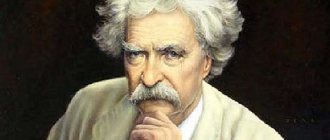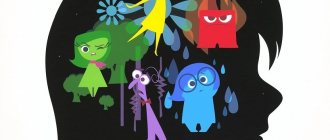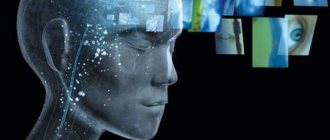Development of perception in preschool children. A person cannot live detached from the world; he feels and understands it with the help of hearing, vision, and tactile sensations. All information enters the brain and is processed efficiently. A preschooler must learn to perceive the world correctly in order to benefit from this for further development.
Features of the development of perception in a child
A preschooler perceives the world through active play, in which he learns and learns something new.
At a young age, preschool children cannot use their imagination; they use the knowledge they receive by using objects. So, if a frog is green, then for a child it can only be green. If an orange is orange, then another fruit of the same color is also an orange for the baby. Three-year-olds do not have a clear perception, they do not know how to analyze.
In the middle groups of kindergarten, pupils already have partial perception. They know colors, they know some geometric shapes, they can compare objects with each other in size and shape, but they do not understand time values. But they can and love to be creative. In many ways, getting to know the world and people for them is about accepting or not accepting appearance and character traits.
Older preschoolers already prefer to see than to hear a hundred times. Auditory perception lags behind visual perception. During this period, the child’s behavior and the qualities of his character are formed, so motivation is important when working with children of this age.
How do children of middle preschool age (4-5 years old) perceive the world?
By the age of 5, children achieve significant success in their ability to perceive various parameters of the world around them:
- There are 7 or more colors;
- Have an idea of light and dark tones, “warm” and “cold” shades;
- Know the basic geometric shapes (circle, square, triangle, rectangle);
- Can compare objects by size (large, smaller, small);
- They begin to form the concept of time (today, yesterday, tomorrow, minutes, hours, days, weeks), but they are not yet able to apply knowledge about these abstract concepts into the life of a four-year-old;
- The perception of other people depends on their popularity in society and their relationship with the baby. Mom will always be perceived by the baby as the kindest and most beautiful.
Types of perception
A preschooler gets to know the world based on:
- visual analyzer,
- opportunity to hear
- thanks to touch.
So, with the help of hearing, a child hears speech, music, and various sounds. Sounds surround the child everywhere: at home, on the street, in kindergarten. With the help of vision, the baby evaluates the world around him, including possible danger. He also learns to love the beauty of his native land, works of art, and other beautiful things, without which a person’s life would be dull. A child's tactile abilities allow him to become familiar with the different textures of the materials around him: hot asphalt in summer or cold icicle in winter - everything matters. These tactile sensations are remembered.
What is the feeling
Sensation (sensory experience) is a mental process, which is a mental reflection of individual properties and states of the external environment that affect our senses. Simply put, it is the body's detection of external or internal stimulation. For example, the eyes detect light waves, the ears detect sound waves.
The sensation process consists of three successive stages:
- Sensory receptors detect stimuli (stimuli).
- Sensory stimuli are converted into electrical impulses (action potentials) that must be decoded by the brain.
- Electrical impulses travel along neurons to specific parts of the brain, where the impulses are deciphered into information (perception comes into play).
For example, when soft tissue is touched, mechanoreceptors (sensory receptors on the skin) note that your skin has been touched. This sensory information is then converted into neural information through a process called transduction. Next, the neural information travels along nerve pathways to the corresponding part of the brain, where sensations are perceived as touching tissue.
There are two points worth mentioning here. First: despite the fact that our body experiences sensations 24 hours a day, we feel only one thing at a particular moment (with the help of attention). After some time, we can remember other sensations, recalling the experience corresponding to them. Second: we are not superheroes, so our sensory experience cannot detect radio waves, x-rays or microscopic parasites crawling on our skin. We also cannot catch all the smells around us or taste and understand every spice in a dish. In this regard, dogs and other animals are significantly superior to us.
Many psychologists have asked the question “How to measure the intensity of a sensation?” The answer has not yet been found, but the thresholds have been identified:
- Absolute threshold: The minimum amount of stimulation that a person can detect 50% of the time. This is the point at which something becomes tangible to our senses. For example, the quietest sound we can hear, or the slightest touch we can feel. Anything below this threshold goes unnoticed.
- The difference threshold (or simply noticeable difference) is the minimum difference that must occur between two body stimuli to identify them as two separate sensations 50% of the time. Here's an example: you hear the sound of a radio in the next room, and then realize that someone has turned up the volume. The difference threshold is the amount of change required to recognize that a change has occurred. However, the difference itself is not absolute. Imagine that you are holding a suitcase weighing 5 kilograms in your hand. If you add 1 kilogram, you will feel the difference. But if it weighs 50 and you add 1 kilogram to it, you will hardly notice it. Therefore, we need to talk about percentages and not absolute ratios. In the first case the difference is 20%, and in the other 2%.
- The final threshold is the maximum amount of stimulation a person can feel.
There are several theories that can help us better understand the concept of sensation.
Signal detection theory
You've probably been in a crowded room with many people talking at the same time. Situations like this can make it difficult to focus on a single stimulus, such as a conversation you're having with a friend.
We often face a similar challenge: focusing our attention on certain things while at the same time trying to ignore the flow of information entering our senses. When we try to confront this, we make conscious decisions about what is important to us and what is background noise. This concept is called signal detection theory because we want to focus on one thing and ignore everything else.
Sensory adaptation
Have you ever wondered why we immediately notice certain smells or sounds, and then after a while we seem to stop noticing them, and they fade into the background? As soon as we adapt to the perfume or the ticking of a clock, we cease to recognize them. This process is called sensory adaptation: perhaps the logic of evolution here is that if the stimulus does not change, then why do we need to constantly feel it?
Levels of development of perception in a preschooler
Perception in preschoolers has three stages.
The first is subject. Children of primary preschool age can only name objects, but are not able to characterize them.
The second is descriptive. From the age of five, preschoolers can describe what they see, compare it with something, and give an assessment.
The third stage is interpretive. Kindergarten graduates can come up with whole stories, fairy tales, supplement the story with their own feelings, and draw conclusions. He is already using the knowledge he has acquired and trying to apply his experience. This practice will be useful for children in first grade.
Exercises and games to develop perception in preschoolers
To develop perception in preschoolers, the child’s age must be taken into account. After all, what is understandable to a five-year-old will be very complex and inexplicable for three-year-olds. In particular, musical games with noise effects of natural sounds are suitable for children of middle and older groups, but not younger ones. It will also be difficult for young children to play with the shades of colors. But they will be interested in finding objects of the desired shape and specific color, and beating the rhythm. Older preschoolers can be offered complex game programs for the development of different perceptions.
Development of auditory perception
There are many sounds in the world, and each object and phenomenon has its own characteristic sound. The child must learn to understand these sounds. How the rain makes noise, how the leaves rustle, how the locomotive hums, how the birds chirp - all this is important. Toddlers do not perceive natural sounds well, but older preschoolers are already able to hear characteristic features if time is devoted to the development of auditory perception. Why is it important to learn to hear? Because without this it is impossible to speak correctly and clearly.
With kids you need to play games that develop a sense of rhythm. Sentencing handclaps are a great idea. With older children, you can already explore the sounds of nature. Walks, excursions through the forest, and the street are suitable for this.
Auditory perception is impossible without auditory attention. Therefore, you need to play “Deaf Telephone” with preschoolers, where you need to activate your hearing.
Another interesting game that children will enjoy is “Radio Theatre”. A preschooler hears a fairy tale that is read role-playing. And the child must find out which character owns the voice, intonation, and phrase.
How to develop auditory perception in children: VIDEO
Development of visual perception
At primary preschool age, children already know the names of primary colors. For them, color perception lives in four colors: red, yellow, blue and green. All other shades are unimportant. In addition, the main assessment is “beautiful” and “ugly,” and the child’s subjective opinion plays a role here.
Later, the child, recognizing new colors and learning to understand them and their shades, begins to more realistically evaluate what he sees. To develop visual perception, you can also suggest drawing a picture using dots. An interesting game will be in which the player is asked to walk through a “labyrinth”. The labyrinth is the path shown in the picture.
There may be a character on one side of the maze, and a character's goal on the other. For example, a child is asked to help a bear cub get to a barrel of honey. So, on one side of the maze there is a bear cub, on the other there is a barrel. The child must lead his finger along the drawn path, looking for the right path. It will also be useful to invite children to find the shadows of any character depicted in the picture. Attentiveness and the ability to notice little things are what this game develops.
Games to develop visual perception: VIDEO
Development of visual perception and attention in children with disabilities: VIDEO
Development of phonemic awareness
Development of perception in preschool children. Phonemic awareness includes:
- the ability to hear and identify sounds in words,
- the ability to determine where exactly a particular sound is located in a word,
- the ability to distinguish words that are similar in sound but different in meaning.
If a child knows how to do this, he will be able to learn to speak correctly, which means he will not have problems at school.
Games where children learn to recognize objects by sounds are well suited for the development of phonemic awareness. For example, a whistle whistles, cereal rustles, water makes noise, a car hums. It is also important to teach your child to hear soft and loud sounds and recognize them correctly. Another feature of phonemic perception is the understanding of the distance or proximity of sounds.
To develop phonemic awareness, the teacher often uses audio recordings with sounds of nature, and then invites children to answer what exactly they heard, offering pictures that depict various natural phenomena.
A good game would be to invite preschoolers to find out what is in the box. The box is shaken, and by the sound the children try to find out what is hidden.
To help children learn to identify the source of a sound, you can play “Bell.” In this case, the presenter places a blindfolded player in the center of the hall, and hands one of the children a bell. The child is calling. The player wearing the blindfold must indicate the direction from which the sound is coming.
Techniques for the development of phonemic hearing: sound-letter analysis in children with ODD: VIDEO
Games for developing phonemic awareness: VIDEO
Development of musical perception
Development of perception in preschool children. If very young children distinguish music by contrast, then by the age of three they already remember individual melodies they like. By the age of five, children not only sing songs, but also understand the musical mood and can distinguish the tempo of music, dynamics, duration of sounds, and rhythm. Older preschoolers are able to distinguish musical works by emotional coloring and know the terms. Children can even tell you how they feel when they hear a particular tune.
Many teachers believe that in preschool age it is useful for children to listen to classical works: N. A. Rimsky-Korsakov, P. I. Tchaikovsky, D. D. Shostakovich and others. It is also useful to introduce children to folklore. Folk dances and songs are a good opportunity not only to introduce preschoolers to folk art, but also to develop children’s musical perception.
The third step is to teach the children songs written specifically for this age. These can also be songs from children's films and cartoons. Moreover, all songs must be in genres known to children.
Development of tactile perception
PERCEPTUAL PSYCHOPHYSICS
The stimulus completely determines the image - it has everything. But the subject's activity is necessary to differentiate the stimulus. Subject-oriented theories:
theory of unconscious inferences G.L.F. Helmholtz; Gregory's theory of perceptual hypotheses; Bruner's theory of perception as a categorization process.
The subject himself builds his own perceptual image. Perception is the process of solving a problem.
G.L.F. Helmholtz: with unusual stimulation - an inference about the nature of the stimulus. We select what is useful. This process is the instantaneous nature of the unconscious: 1) there is no reliance on conscious knowledge; 2) irresistibility; 3) follows from past experience (by analogy); 4) the influence of habit, training.
Gregory: when encountering a stimulus, perception puts forward a number of possible interpretations of the image - object-hypotheses. Hypotheses must be plausible. They are limited by past experience. Inconsistency of hypotheses causes an affective reaction.
Bruner: There are perceptual categories - a set of rules for combining objects: generalized ideas about an object stored in past experience. Perception is the solution to the problem of classification, assignment to a category (inference operation). Subject activity.
The categories differ in their readiness (minimizing surprises, maximizing success). Categorization depends on motivation. A measure of the truth of perception: correspondence between the readiness of the category and the probability of real events.
Process of perception: presentation of an object for a very short time - primary categorization.
The subject already has a perceptual readiness to perceive a particular object - a category. The category’s readiness to be discovered, to be transferred from past experience to the present.
Search for signs. If they confirm the category, then a confirmatory check.
Making the final decision. Closedness to additional features.
Possible perceptual conflict (illusions).
Perceptual adaptation - pseudoscope. The world loses its objectivity before the subject begins to act.
Orientation towards interaction, cognition as an understanding of reality: the source of image construction is contact with the object;
• no importance is attached to past experience - only the present;
• perception and thinking become independent processes.
Gibson's ecological theory:
The world is an ecological niche, the habitat of the subject (the subject and the world are not separated). The act of perception is not two-phase (receiving a retinal image and processing information) - there is no need to interpret anything! Perception is not thinking. You must be able to extract information in direct contact with the world. The world has everything necessary for perception.
We perceive not with the retina, but with the whole body - the principle is built-in. Perception is a psychosomatic act of a living observer. Retrieval of information is an active and continuous process. The information is non-specific regarding receptors (cf. Müller).
Methods for developing different types of perception
Here are several methods for developing perception of different types.
Size, color and shape
In this case, children are asked to take out objects of only one color from the boxes. Or suggest taking out only square objects, or only round ones. You can prepare boxes painted in different colors, and in them the child must put objects of the color in which the box is painted.
What's lost?
In this game, not only vision and attentiveness work, but also thinking. The child is asked to look at a picture showing different objects. But they are not finished yet. For example, a bicycle is missing a wheel, and a house has no windows. The child must tell what is missing.
Smell and guess
Smell works in this game. The child is blindfolded, in front of him are vegetables and fruits, and other products that the player must name, guided by smell.
Magic sound
A game that awakens the imagination and ears. Child with closed eyes. The presenter plays sounds, including the audio system: the sound of rain, the sound of a steam locomotive, the chirping of birds, etc. The child names who the sounds belong to.
Tactile riddle
There are objects in the container. The child, without looking, must determine by touch what it is. Objects must be of different sizes, shapes, smooth or rough.
Touch
Tactile sensations are the most ancient type of sensory sensitivity, which arose in living organisms much earlier than not only vision and hearing, but also smell. Touch is also more often referred to as sensations than to full-fledged perception; there is too much of the physiological and reflexive in it. However, the role of touch in life becomes clear in a difficult situation when a person loses his sight. Then tactile sensations become conscious and can partially compensate for the inability to see, as they provide information about the shape of objects.
The fingertips and palms have the greatest sensitivity in humans. They are connected by a huge number of nerve fibers to various parts of the brain. Therefore, we can say that the level of mental development of a person largely depends on his fingers
It’s not for nothing that child psychologists pay so much attention to the fine motor skills of children’s hands.
Perception disorders and causes
Development of perception in preschool children. Perception disorders are the inability to correctly perceive surrounding sounds and objects. Such a person is disoriented; he cannot really assess the reality around him.
The causes of perception impairment may be:
- pathology of the central nervous system, including due to diseases;
- mental disorders;
- reaction to taking complex medications such as antidepressants, antivirals and others;
- drug addiction, including congenital;
- trauma resulting in damage to the nervous system;
- physical and mental fatigue of the body;
- visual defect.
A child suffering from perception disorders needs to work with specialists who will create an individual program. But at the same time, the family can help solve the problem in the following ways:
Follow a daily routine
Get up and go to bed at the same time, eliminate those actions that cause fear and emotional stress.
Light
The child does not perceive the shape and color of objects well, and in poor lighting it becomes even worse. Therefore, the light should be bright, but soft.
Colors
So that the nervous system does not experience additional stress, it is necessary that the child’s room has as little gloss and ornaments as possible and as many solid colors as possible.
Daily activities to develop perception
Games to develop the ability to understand the size, size and shape of an object, as well as its color, and to develop sound and visual perceptions should be built taking into account the characteristics of children with disabilities. For example, you can offer to play such a game. It is proposed to insert an element of the same shape into specific puzzles. Of course, the child will not succeed right away, but over time he will experience small success. You can also use games that require tactile sensations. Playing with sand is also calming and develops fine motor skills.
Psychological theories and schools
Perception disorders have been studied by representatives of various psychological schools.
They used different theoretical bases as well as practical techniques.
- The first to emerge was the teaching of the structuralists. They were I. Muller, G. Helmholtz, E. Goering and E. B. Titchener. They believed that a holistic image of an object in a person’s mind is formed from a combination of sensations received from various analyzers.
The structuralist technique was called analytical introspection. With its help, they studied sensations—the “bricks” from which perception is built. They decomposed one image into separate perceptible parts and studied them in natural conditions. And they noticed that with similar sensations, a combined perception of different objects is formed by associative means.
- Gestalt psychologists became critics of the structuralists. Prominent representatives were M. Wertheimer, W. Keller and K. Koffka. In their opinion, a person perceives objects, objects and the situation as a whole as if they were a single complex of external stimuli. Their technique was called phenomenological, when a person was asked to describe the full range of his sensations. Moreover, in similarly perceived situations, it was believed that similar processes occur in the brain. Gestaltists also considered all sensations to be innate.
- The ecological theory of perception was proposed by J. Gibson. According to it, the environment is actively explored by man through an active search by man for signals from the outside world. It is the streams of stimuli that give rise to sensations that shape perception. Perception itself is interpreted as a means of human adaptation to the outside world.
- In 1961, J. Piaget, working with children, came to the conclusion that perception is a property of the psyche that develops throughout human life. With its help, a person gradually learns to isolate and find common details from incoming sensations, as well as to control his movements in accordance with the information received.
What influences the development of perception in a child
Development of perception in preschool children. At preschool age, a child’s mental development is formed, and thinking begins to actively work. If any perception is “asleep,” it will be more difficult for the child to explore the world and acquire new knowledge, which means it will be more difficult for him later in school.
The development of a child’s perception is greatly influenced by his environment and the adults who are next to him. Educational games, which are used by teachers to develop perception, should not only simply reproduce some details from a child’s life, but also be informative, teach him, force him to learn more. It is the desire to know and try that becomes a kind of motor that moves the child in his development.
Peculiarities of perception in older preschool age (5-7 years)
In older preschool age, as before, visual sensations dominate perception. Auditory perception begins to actively develop: children are able to identify sounds in words, recognize familiar musical compositions, and feel the tempo and rhythm of a piece. Six-year-old children are well oriented in space (they practically do not confuse “right” and “left”, perceive distances between objects quite accurately, and can navigate plans and diagrams). The perception of time periods (minute, hour, day, and so on) depends on how often parents mention them in communication with their children. If you give your child tasks in which time is one of the guidelines (for example, “draw as many circles as possible in a minute” or “you need to brush your teeth for 2 minutes”), gradually it will no longer be so incomprehensible to the child.
The leading channel of perception for most older preschoolers is vision. At the same time, other types of sensitivity (especially auditory and tactile) are also actively developing.










